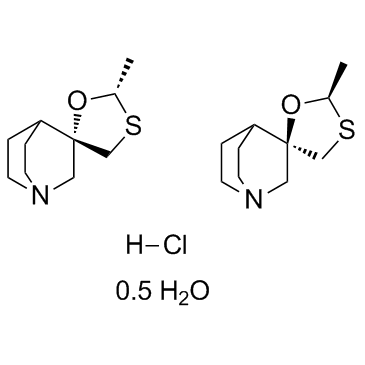


We are Cevimeline Hydrochloride Hemihydrates CAS:153504-70-2 manufacturer and supplier in China, Pls send inquiry of to info@nbinno.com of visit www.nbinno.com our official website should you have any interests

Product Description
Product Name: Cevimeline hydrochloride hemihydrates CAS 153504-70-2
Synonyms:
Cevimeline hydrochloride hemihydrate;
cis-2-Methylspiro(1,3-oxathiolane-5,3”)quinuclidine hydrochloride hydrate (2:2:1);
(+/-)-cis-2-Methylspiro[1,3-oxathiolane-5,3”-quinuclidine] hydrochloride hemihydrate;
(+/-)-cis-2-methylspiro[1,2-oxathiolane-5,3”-quinclidine] monohydrochloride;
Cevimeline HCl 1/2H2o;
(+/-)-cis-2-methylspiro[1,3-oxathiolane-5,3”-quinuclidine] monohydrochloride;
cevimeline hydrochloride;
(+/-)-cis-2-methylspiro[1,3-oxathiolane-5,3”-quinuclidine]monohydrochloride hemihydrate;
CeviMeline hydrochloride hemihydrates;
CevimelineHCl;
Chemical & Physical Properties
Appearance : White powder
Assay :≥99.0%
Density:1.19g/cm3
Boiling Point:308.5℃ at 760 mmHg
Flash Point:140.4℃
Cevimeline hydrochloride hemihydrate, a novel muscarinic receptor agonist, is a candidate therapeutic drug for xerostomia in Sjogren”s syndrome. IC50 value:Target: mAChRThe general pharmacol. properties of this drug on the gastrointestinal, urinary, and reproductive systems and other tissues were investigated in mice, rats, guinea pigs, rabbits, and dogs. The in vitro metab. of SNI-2011 was also evaluated with rat and dog liver microsomes. After oral administration, plasma concns. of SNI-2011 reached to Cmax within 1 h in both species, suggesting that SNI-2011 was quickly absorbed, and then decreased with a t1/2 of 0.4-1.1 h. The bioavailability was 50% and 30% in rats and dogs, resp. Major metabolites in plasma were both S- and N-oxidized metabolites in rats and only N-oxidized metabolite in dogs, indicating that a large species difference was obsd. in the metab. of SNI-2011. Sex difference was also obsd. in the pharmacokinetics of SNI-2011 in rats, but not in dogs. In the in vitro study, chem. inhibition and pH-dependent studies revealed that the sulfoxidn. and N-oxidn. of SNI-2011 were mediated by cytochrome P 450 (CYP) and flavin-contg. monooxygenase (FMO), resp., in both species. In addn., CYP2D and CYP3A were mainly responsible for the sulfoxidn. in rat liver microsomes.
If you are interested in our products or have any questions, please feel free to contact us!
Products under patent are offered for R & D purpose only. However, the final responsibility lies exclusively with the buyer.
Related Products:2-dipropoxyphosphoryl-5-pentyl-1,2,4-triazol-3-amine manufacturer | 2-dipropoxyphosphoryl-1,2,4-triazol-3-amine supplier | 6-tert-butyl-2-piperidin-1-yl-4,4-bis(trifluoromethyl)-1,3,2λ<sup>5</sup>-dioxaphosphinane 2-oxide producer.
| Product Name | |
|---|---|
| 4-Bromo-1,1,2-trifluoro-1-butene Cas:10493-44-4 | View Details |
| N,N’-Diisopropylcarbodiimide Cas:693-13-0 | View Details |
| 2,4-DIFLUORO-3-METHYLBENZOIC ACID | View Details |